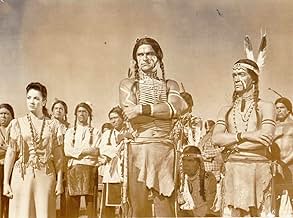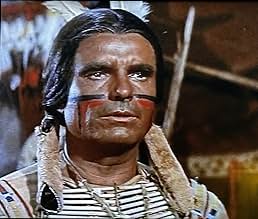Ajouter une intrigue dans votre langueCommon efforts of the U.S. government and the Comanche nation to negotiate a peace treaty are sabotaged by renegade Indians and by the short-sighted Indian Commissioner (Lowell Gilmore).Common efforts of the U.S. government and the Comanche nation to negotiate a peace treaty are sabotaged by renegade Indians and by the short-sighted Indian Commissioner (Lowell Gilmore).Common efforts of the U.S. government and the Comanche nation to negotiate a peace treaty are sabotaged by renegade Indians and by the short-sighted Indian Commissioner (Lowell Gilmore).
- Downey
- (as Stacey Harris)
- Margarita
- (as Miss Linda Cristal)
- Medicine Arrow - The Medicine Man
- (non crédité)
- Scalphunter
- (non crédité)
- American Soldier
- (non crédité)
- Scamphunter
- (non crédité)
- Scalphunter
- (non crédité)
- Young Girl Killed by Indians
- (non crédité)
- Young Boy Killed by Indians
- (non crédité)
Avis à la une
I hate to say it but Kent Smith isn't convincing as Quanah Parker. If they were going to have this kind of robotic dialog, then they should have at least gotten Charles Bronson or Steven McNally to do it since they look more Indian-like than the blue-eyed, fair-haired Smith does. Yeah, I know Parker was half-white and all that, but still...
Plus you have Dana Andrews and the rest of the cast looking like they are sleepwalking through the whole thing. It's as if everyone is just going through the motions with little or no effort. Were they bored with it, or was it only what the script demanded?
The only character who was remotely interesting was Andrews' sidekick Puffer, played by Nestor Paiva. He looked sufficiently grizzled for the part without resorting to too much of the silliness that say, Gabby Hayes would have done if he had played the role. It's too bad his part wasn't bigger.
The battle scenes look lame even by 50s standards with the whole thing having a rushed look to it, despite the widescreen technicolor cinematography by George Stahl. This use of color was a rarity on United Artists part since they mostly shot their westerns in b/w.
And with the title music sung by The Lancers sounding all hokey and Disney-like, all it does is bring it down a couple of more notches for me.
3 out of 10
Actually it doesn't because from the outset we're shown it's the Mexican/Hispanic community who are all to blame . We're given a short history lesson that when Spain conquered Mexico the Spanish held the Comanches at gunpoint and made them work down the mines gathering silver . Understandably the native population were a bit angry about this and revolted leading to the Spanish to stamp upon them . After Mexico gained its independence the slaughter continued with Mexicans putting a bounty on Indian scalps 100 dollars for a warrior , 50 dollars for a squaw and 25 dollars for a child
" Wow Theo that is so cruel and if anyone did that today they'd be getting arrested and tried for crimes against humanity at The Hague "
Undoubtedly and rightly but you have to ask yourself a rhetorical question that would the native population of the United States be getting a better deal ? No they wouldn't this film tends to ignore this and seems to portray the United States White Anglo-Saxon Protestant as being morally superior to that of their Hispanic neighbours who are portrayed as being as untrustworthy but are very good guitar players and it's left to an American WASP to save the day
This cultural arrogance is not so much offensive but a great pity because COMANCHE did have some potential to be a good Western that would have appealed to people who don't like the Western genre . It does try to push the boat out against the Hays Code by having a slightly sadistic streak but then sabotages it by including a couple of songs over the soundtrack
The shooting location Durango, Mexico has the desert qualities although the Mexican filming looks a little inferior. This is a B-movie Western but it's a pretty good one. It tries to deal the complex relationships of the people in the area. It's interesting that the Comanche chief is so astute right away. I don't like the red-faced actors but it's not unusual for its time. The quality is second tier but it's at the top of that second tier.
A routine and standard oater but passable Indian/Cavalry western with two Comanche tribe leaders , one good- Kent Smith- , and the other evil -Henry Brandon- clashing each other and a scout -Dana Andrews- attempting to keep peace and order . Decent , gleaming Western with noisy action , go riding , pursuits , Indians attacks , Cavalry charges , and shootouts . This glittering picture results to be an ordinary oater but containing some novelties , as the historical remarks about Quana Parker and General Miles . Stars the prolific Dana Andrews who had a long career and played a lot of Westerns . He first worked in Metro Goldwyn Mayer , it was two years before Goldwyn and 20th Century-Fox , to whom Goldwyn had sold half of Andrews' contract, put him in a film, but the roles, though secondary, were mostly in top-quality pictures such as The Westener (1940) and Ox-Bow incident (1942). A starring role in the hit Laura (1944), followed by one in The best years of our lives (1946), made him a star, but no later film quite lived up to the quality of these. During his career, he had worked with with such directors as Otto Preminger, Fritz Lang, William Wyler, William A. Wellman, Jean Renoir, and Elia Kazan. Andrews is well accompanied by a good main and support cast such as : Kent Smith , Henry Brandon ,Stacy Harris , Lowell Gilmore , Nestor Paiva , Mike Mazurki and the beautiful Mexican Linda Crystal in her film debut.
It contains a rousing and moving musical score by Herschel Burke Gilbert with catching songs by The Lancers . As well as glimmer Cinematography in shining Technicolor by Jorge Sthal Jr. shot in Mexico . The motion picture was competently made by George Sherman in B-style , though has some flaws and gaps . Entertainment , atmosphere , action and excitement surge along with the tale under the hand of filmmaker George Sherman , who is clearly more at home with the thrilling scenes than somewhat talking scenes. Sherman made reliable low-budget fares for Columbia between 1945-48, then moved on to do the same at Universal for another eight years . Sherman specialized almost exclusively in "B" westerns there , including the "Three Musketeers" series, which featured a young John Wayne. George directed lots of Westerns as ¨The Last of the Fast Guns¨ , ¨The Lone Hand¨, ¨Santa Fe stampede¨ , ¨Red skin¨ , ¨Chief Crazy Horse¨ ¨Calamity Jane¨, ¨Relentless¨ , ¨Comanche Territory¨ , ¨Dawn at Socorro¨, ¨Border River¨ and many others . He also made occasional forays into action and horror themes, often achieving a sense of style over substance . The only "A"-grade films to his credit were two westerns starring John Wayne: ¨Comancheros¨ (1961) (as producer) and ¨The big Jack¨ (1971) . His last films were realized in Spain as "Find That Girl" , ¨The new Cinderella¨ and ¨Joaquin Murrieta¨. Rating : 6/10 . Acceptable and passable . Well worth watching.
The film is partially based on the notorious Indian figure Quanah Parker (Comanche kwana, "smell, odor") , he was a war leader of the Quahadi ("Antelope") band of the Comanche Nation. He was born into the Nokoni ("Wanderers") band, the son of Comanche chief Peta Nocona and Cynthia Ann Parker, an Anglo-American who had been kidnapped as a child and assimilated into the tribe. Following the apprehension of several Kiowa chiefs in 1871, Quanah emerged as a dominant figure in the Red River War, clashing repeatedly with Colonel Ranald S. Mackenzie. With European-Americans deliberately hunting American bison, the Comanches' primary sustenance, into extinction, Quanah eventually surrendered and peaceably led the Quahadi to the reservation at Fort Sill, Oklahoma. He was never elected chief by his people but was appointed by the federal government as principal chief of the entire Comanche Nation, and became a primary emissary of southwest indigenous Americans to the United States legislature. In civilian life, he gained wealth as a rancher, settling near Cache, Oklahoma. Though he encouraged Christianization of Comanche people, he also advocated the syncretic Native American Church alternative, and passionately fought for the legal use of peyote in the movement's religious practices. He was elected deputy sheriff of Lawton in 1902. After his death in 1911, the leadership title of Chief was replaced with Chairman; Quanah is thereby described as the "Last Chief of the Comanche," a term also applied to Horseback. He is buried at Chief's Knoll on Fort Sill. Many cities and highway systems in southwest Oklahoma and north Texas, once southern Comancheria, bear references to his name.
Le saviez-vous
- AnecdotesDana Andrews had a severe drinking problem during this period. While shooting this film he also fell in love with his leading lady, Linda Cristal, making her American film debut. While not big news in the tabloids stateside, Mexico--where this film was shot--had a field day with this news about the co-stars. When Andrews phoned his wife Mary and told her that even she would like Linda, Mary hopped on a plane to Mexico.
- GaffesIt was Chief Joseph of the Nez Perce who said, "I will fight no more, forever," not Quannah Parker.
- Citations
Quanah Parker: I do not think of Americans, only of Comanches... and the children of Comanches... and the children that will come from those children. The Americans are here. They will stay. We cannot drive them out. They will grow strong while we will not. We must learn from them so that our children will not hunger... so they will be warm in winter... so they will strong as the Americans are strong.
- ConnexionsSpoofed in Once Upon a Time in... Hollywood (2019)
- Bandes originalesA Man Is As Good As His Word
Lyrics Alfred Perry
Music Herschel Burke Gilbert
Sung by The Lancers
Coral Recording Artists
Meilleurs choix
- How long is Comanche?Alimenté par Alexa
Détails
Box-office
- Montant brut aux États-Unis et au Canada
- 1 150 000 $US
- Durée
- 1h 27min(87 min)
- Couleur
- Rapport de forme
- 2.35 : 1



















